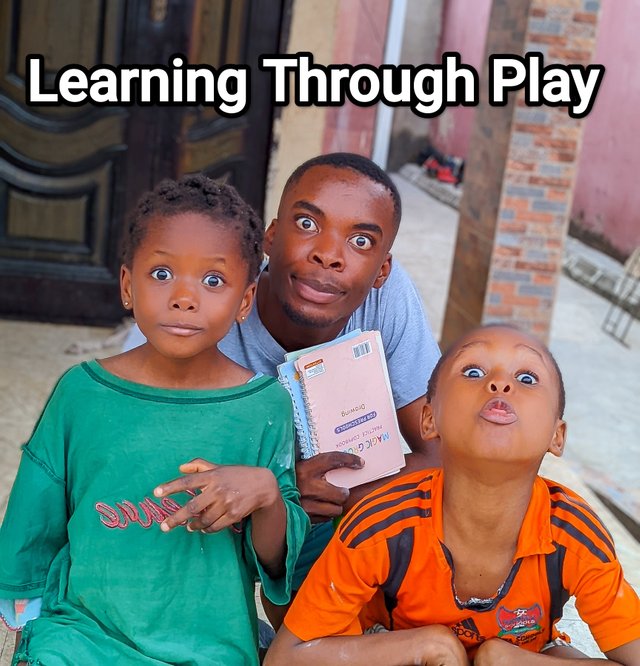
Learning with play has always been a strategy used in lower classes where kids are predominant to help stimulate interest in learning. It's not been an easy milestone for this to be accomplished, though, by the teachers involved. Most times, it takes them serious work to tame these kids. In my primary school, I was also a part of this play. Songs would be played for us to dance to for 10 minutes, and then we would go back to learn the usual ABC.
In the absence of light to tune the songs, the teachers would tell us to stand. We'll do some stretches in class, which includes catching the ball, jumping to the left and right, and then sitting down. This was done to make learning interesting and the class lively.. So how effective is play in learning, and is it focused on some set of individuals or...? The questions below give answers.
In your opinion, is this learning-through-play method effective in a learning activity? |
|---|
In my opinion, the learning-through-play method is effective in a learning activity because it brings about lots of benefits to both the teacher initiating this play and the students absorbing these plays. Some may see it as a waste of time, something childish that brings disorganisation or a form that may cause distraction and deviation from the course of study.
Actually, these disadvantages are not exempted based on how the teacher initiates the play. I'll be reasoning on a few benefits of why it's effective with illustrations. There's a saying by Benjamin Franklin as I quote, “Tell me, and I forget. Teach me, and I may remember. Involve me, and I learn." This statement of his implies the essence of learning through play, which makes learning activities lively, interactive, and retentive for learners. Something you learn with play can't easily be forgotten. You'll always remember it. That's a striking point to deliberate on... Retention
- Retention: In my primary school days, there's a mat that has numbers written on it, and this mat is usually used in numbers class. We would hop on the numbers in the mat to learn concepts like addition and subtraction and also learn the numbers individually. In number two, two pupils will enter the box while a pupil will enter the number 1 box. To learn addition, the pupil in box 1 will join us in box 2, and we'll become three. To learn subtraction, the pupils in box 2 will remove one pupil from the box, and the box will now just have a pupil. It was just so fun.
Now the essence of this is to help us remember our numbers and how addition and subtraction are done so that when asked in exams, we'll remember the game, and it would be easy for us to do the mathematics even if it involves drawing the box on a piece of paper to know. We also knew the arrangement of numbers from the Number Hop game. We knew that after 3 is 4. You see, I'm relating the experience because I haven't forgotten.
- Builds Confidence and Independence: How? Most pupils today aren't confident in themselves as to whether they would be able to solve a problem or answer a question correctly. They depend on others to copy from SD; they doubt themselves. Integrating the play way method, in which pupils have roles to play either as a doctor, teacher, or another character in a comprehension. When they get to act these roles or even teach what was taught in class as a role teacher to students, they are engaged and try as much as possible to be independent, fearlessly.
- Engagement and Motivation towards Learning. Playing is effective in teaching as it motivates the learners and builds their interests to learn a particular subject, preventing boredom or an uninteresting class. I can remember watching a movie where a teacher asked the students to find a physical object in class. Everyone started finding that object till they saw it, and that object was used to teach. Just see how the teacher diverted the students attention from what they were thinking or doing to the clock. They were engaged, though, and were motivated to listen attentively in class. That small intermission where they were asked to look for a clock or probably the stand-and-sit play method as shown in the video helped revive the class from being too silent and boring.
- It encourages cognitive development among students and development of social skills. How? When games like puzzles are introduced for children to play and match, they become intellectually able as their thinking ability increases, and they get to understand problem solving better through the puzzle. With this play, they are able to think critically and also look for ways to logically tackle a problem either in an exam hall or test.
As to the development of social skills, teamwork games serve as that playway method that brings the students together, which fosters cooperation and can even make the most introverted person become an ambivert or extrovert if care is not taken.
Learning isn't about helping the students understand a material by instilling knowledge. You look for ways to be strategic so that the knowledge can be passed in a way the students would understand easily without being confused or losing interest in the class. That's where play seems to be effective, though this strategy for effective learning and teaching works best for pupils and not grown-ups in a class setting, but outside a class setting, it works best for all kinds of students.
Create your own version of a game that is useful for learning activities. Explain specifically how to play the game. |
|---|
Playing with Tools
- Chalkboard
- Chalk
This was a version I created yesterday. I don't know how the idea came to my head, but I just did it with the children I taught yesterday. The game is the X and O box that is played by two people. Before playing this game, I taught my pupils what a noun is, and I used illustrations to help them understand what a noun really is.
From the video, you'll see clearly how I manipulated the explanation of the noun topic to the understanding of my pupils. Seeing that the class was less lively than expected, I diverted my attention to making it even more lively by using the game that's relative to the topic.
The nature of the game is that you'll have to mark your boxes. The first person to completely mark his or her box wins the game, and I promised to sponsor the lunch of the winner to motivate them. Now, they were to pay attention to what I said. If I mention a noun, they were to mark the box in the noun column. If I mention something outside a noun, they'll mark the second box. I taught these pupils what a noun is, and they are familiar with nouns as they indicate names of persons, places, things, and animals.
See, as I integrated reward learning with the play way learning strategy. I drew two boxes on the board and then stationed two pupils to take each box. The pupils took their turns and were alert to what I said....
So if I mention Canada, they know Canada is the name of a country and is the name of a place. They ticked the Noun Box, and I called these Nouns fast so they won't have time to fill the boxes. Their ability to recollect what I said improves thinking ability and memory retention. If you noticed, the boy here had to store up information I said in his head to the extent that even when I was done calling out the nouns, he used what he heard to fill the boxes and was declared the winner. This is the game I used to make their memory retentive to what I taught.
- Bodily Movement
- Clapping of the Hands
- Use of ears and eyes.
These are areas I used with the children in the absence of essential tools asides the chair to play at first since this is a classroom setting. I ensured they were actively involved in this game and it's outrightly stated in the next question as to what type of game I introduced without the use of tools to play.
Now, looking at the context of the video above, you'll see that the game played without tools was more of turning round a chair and sitting down first after the stop of a music. The very essence of using this game without tool is to encourage active participation and listening between the children I was teaching and I was able to accomplish that before diverting my attention to using the tool game to bring them back to the subject matter which is a Noun.
How these games help in the learning process |
|---|
The games played by these children actually help in the following ways which includes;
- Active Participation and attentiveness in class: It's actually common among children to play in class even when the teaching is teaching. Their attention is divided. The integration of this game where they have to pay attention in order to win helps the children pay attention in class in other to answer questions correctly
- Memory retention: The use of the X and O box pattern to teach them what a Noun is by stating the categories of a noun will help them know what Nouns are even in their dream. It will also help in making the children remember that anything that is not a name of a person, animal, place or thing should be cancelled and that it's not a Noun. They can even use it in their examinations as a retentive guide.
- Additionally, active participation and engagement is forthcoming with these games as the children would want to try new things in class, answer questions and even read comprehensions because that self-confidence has been bolstered. Those who dislike talking or answering questions in class would be all weather with these games. It brings out the person in a student.
Share photos and videos as you try out a game you've created at home or share as you do it with your students. |
|---|
Since we were told to share just videos and pictures without explanations, I would do the needful but with a few pieces of information regarding the videos. The children I taught are under the age range of 5-7 years, and the integration of the play method was to make learning interesting and stimulate interest in the minds of these children.
 |  |
|---|

From the videos, I used about three games for this purpose but didn't make the games the primary purpose of learning to avoid deviation from the subject matter. The end result justified the means in that these children were so happy I was the one teaching them. In fact, they didn't want me to leave since it was a home lesson I was doing.
What do you feel after trying the game? Is it effective for the subject you teach? |
|---|
I felt justified and relieved somehow that I introduced a learning strategy for retention of memory and enhancement of thinking ability and social skills. The game I used was actually introduced by me at home before going to teach the children. There are some children that don't respond favourably to play of any kind except it's matured. Considering the age of these children and what they like made me introduce the stand and sit game.
My introducing the game in the class made learning an interesting one. Even I, as the teacher, didn't feel an inch of boredom, and the children were active and responsive as well. When I noticed the class was getting less interesting, I introduced the game to make learning interesting and bring their sole focus on the subject area.
I played the stand and sit game. This was to make them act lively in a class, as sitting for too long can cause boredom and can actually make you feel uncomfortable. I told them to stand and sit. Anyone who did an action that wasn't mentioned would lose the game, and in most cases the girl lost, but the boy did lose as well.
They saw it to be very interesting, and the lesson they derive from this game is to be an active listener in class and avoid any form of distractions. Distractions made her sit when I said stand. She learnt something valuable, and in my last round, she got it perfectly while the boy lost to her.

The next game was also an active listening game where you have to pay attention to the song until you hear sit. This one involved just one chair, and your active listening to the song will tell you when to sit. The boy won on most occasions, though. The game ended in a sweet way where I had to remind them with another game that we were talking about nouns. That was how I was able to use this strategy as an effective teaching strategy to enhance learning.
In summary, it's not every time you play formal with students to accord respect. Sometimes, introducing comic relief and fun time during lectures can actually make learning interesting and less boring. This is the method most lecturers use with us in higher education since we are grown-ups, and it's classified as a playway method as well. With this integration, you've accomplished a lot in the learning process of an individual as a teacher. This is in fact my seminar topic at the university.
I invite @whizzbro4eva, @sahmie, @kouba01
Cc,
@miftahulrizky
Wow, this is exhaustive and detailed. And integrating play into learning is a sure way to motivate learners. From your post, i have learnt that even the seemingly dull and apathetic ones in class may shine bright and find the urge to learn.
I also learnt that in spite of the plethora of benefits, they exists danger zones which they teacher must be beware of. I am glad you eliminated most of this during your lesson delivery.
As a matter of fact, this is really worth researching. Congratulations on getting on the pathways towards solving an educational problem.
Downvoting a post can decrease pending rewards and make it less visible. Common reasons:
Submit
Awnnnnnnnn. Thanks for the compliment. I really appreciate. It's not been easy to create a single content these days. Thanks.
Downvoting a post can decrease pending rewards and make it less visible. Common reasons:
Submit
I understand, however, one thing is sure, your oost doesn't lackQuality.
Kudos and more grace to create.
Downvoting a post can decrease pending rewards and make it less visible. Common reasons:
Submit
Your seminar topic, hahahaha, ewo. I remember in my primary school, whenever we wanted to study mathematics, our teacher will ask us to bring bundles of stick. We used the stick when counting, to differentiate addition from subtraction, multiplication as well. The way I was taught 2 times tables make it difficult for me to forget. We always sang it back then. This shows that playing is part of learning as hlit will help the students to concentrate. Thank for this wonderful presentation.
Downvoting a post can decrease pending rewards and make it less visible. Common reasons:
Submit
Greetings Sir @bossj23, such an interesting and intellectual post that you wrote. Through your post, I learned the importance of learning through play and you have explained it with some of your personal experience. Using the mat for teaching the numbers and the X and O game which really improves the confidence and also engaging processes of children. To avoid distraction how a teacher can balance play with learning you explained in detail and so well. This process not only the teacher but also parents can apply at home. The stand-and-sit game is a great play that can keep the children active as well as make the classroom active and lively. Through the play, you made the learning process of the children which is so much fun. These types of little fun and creative ideas can make the educational process memorable and also meaningful to the students by keeping them engaged. Thanks for sharing your thoughtful and essential educational learning process with some physical experiences with us.
Downvoting a post can decrease pending rewards and make it less visible. Common reasons:
Submit
Had a great time playing with the kids. The children look magical. Very beautiful to see. You seem so happy to be spending time with the kids. Honestly I also love spending time with kids and kids love me so much good luck for you love kids like this @bossj23
Downvoting a post can decrease pending rewards and make it less visible. Common reasons:
Submit